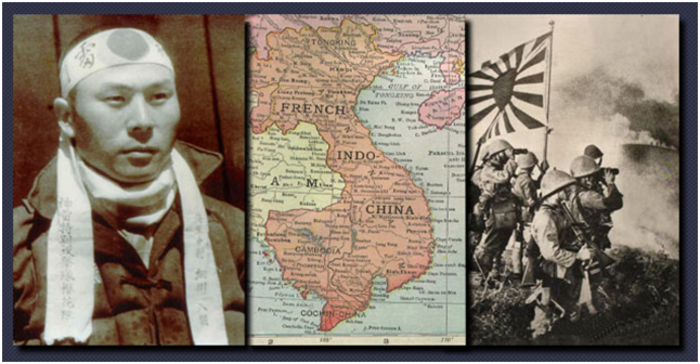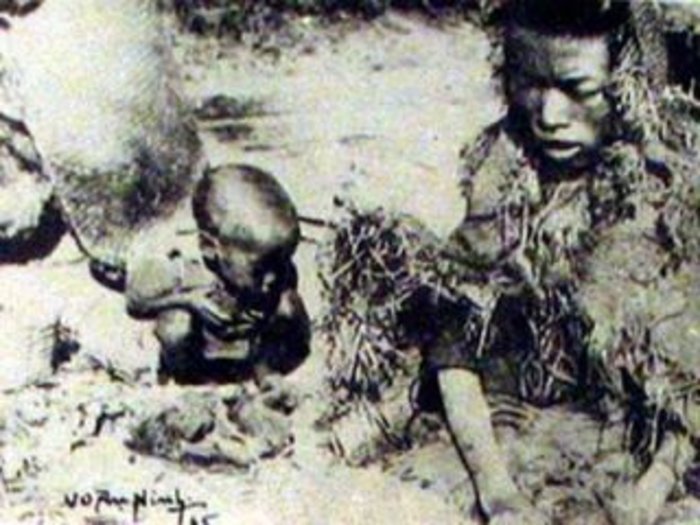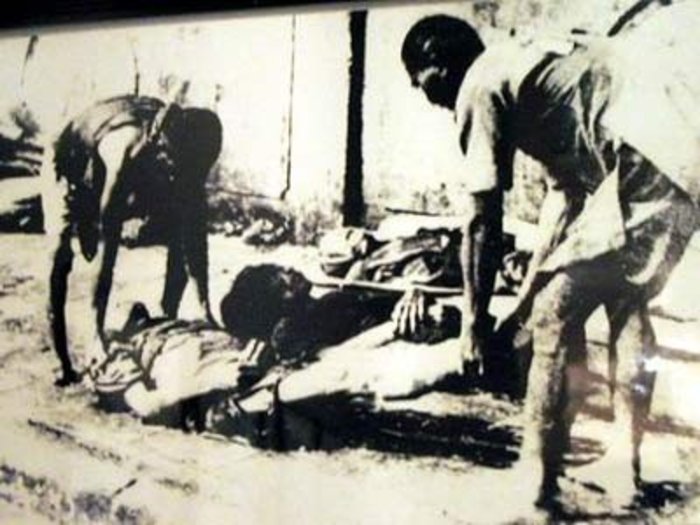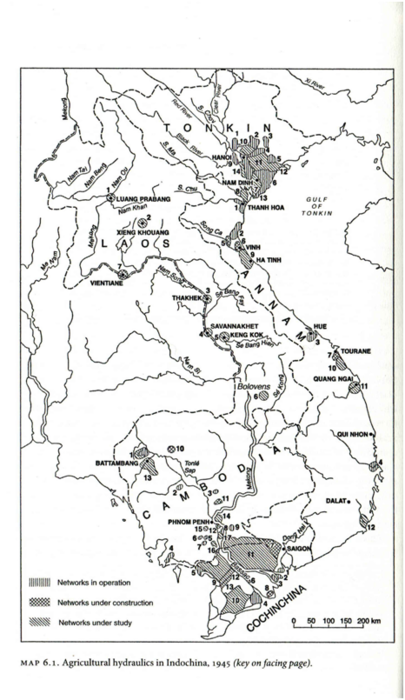Vietnamese famine of 1945
This article has multiple issues. Please help improve it or discuss these issues on the talk page. (Learn how and when to remove these template messages)
|
| Vietnamese Famine of 1945 Nạn đói Ất Dậu | |
|---|---|
 Children in the famine | |
| Country | French Indochina, Empire of Vietnam |
| Total deaths | 400,000—2,000,000 |
The Vietnamese famine of 1945 (Vietnamese: Nạn đói Ất Dậu – famine of the Yiyou Year or Nạn đói năm '45 – the 1945 famine) was a famine that occurred in northern Vietnam in French Indochina during World War II from October 1944 to late 1945, which at the time was under Japanese occupation from 1940 with Vichy France as a puppet government of Nazi Germany in Western Europe. Between 400,000 and 2 million people are estimated to have starved to death during this time.[1][2][3]
According to a 2018 study, the primary cause of the famine were typhoons that reduced the availability of food, Japan's occupation, American attacks on the Vietnamese transport system, and French colonial administration hindering an effective famine alleviation response.[4]
Causes

The famine had many causes. The direct cause was the effects of World War II on French Indochina. The involvement of France and Japan in Vietnam caused detrimental effects to the economic activities of the Vietnamese. In 1944, after US bombing cut off supplies of coal from the north to Saigon, the French and Japanese used rice and maize as fuel for power stations. According to diplomat Bui Minh Dung, "the Japanese occupation of Vietnam was the direct cause, in the final analysis, of several other factors, in turn affecting the famine, but their military efforts together with their economic policy for the Greater East Asia Co-Prosperity Sphere per se seem to have systematically played a role considerably greater than any other factors in the Vietnamese starvation."[2]
The mismanagement of the French administration in Vietnam was the indirect cause. The French reformed the economy to serve the administration and to meet the needs of war because they had been invaded themselves. Natural causes included natural disasters such as droughts and floods, which destroyed northern crops.
The crop failures of 1943–45 were compounded by lack of dike maintenance following US bombing of the north and the catastrophic rainfall of August–September 1944, causing flooding and loss of rice plants.
French colonial administration
After the Great Depression in the 1930s, France returned to its policy of economic protectorate and monopolized the exploitation of natural resources of French Indochina. The people in French Indochina had to increase the economic value of the area by growing cash crops in place of lower-value agricultural produce, but only the French, a small minority of Vietnamese and Hoa and some people in the cities benefited.
A similar poor harvest as in the famine had happened in 1937, but the administration had managed to counter it by preparing food reserves and a series of public works projects for poor farmers, akin to the American New Deal.[2]
World War II
When the war started, France was weakened. In East Asia, Japan began to expand and viewed French Indochina as a bridge into Southeast Asia and a means to isolate and further weaken the Nationalist government of China. In mid-1940, Metropolitan France was occupied by Nazi Germany and Japan increased pressure on France and entered French Indochina that September. Vietnam was pulled into a wartime economy, with France and Japan competing in administration. Japanese troops forced farmers to grow jute, instead of rice, thus depriving them of needed food, but France had already started the same policy to a smaller degree. The land set aside for growing staple crops such as maize and potatoes was decreased to make land for growing cotton, jute, and other industrial plants. Because of the decreased land available for growing, harvests of staple crops decreased considerably. Crops were also exported to Japan.
The militaries of both France and Japan forcibly seized food from farmers to feed their troops. By 1941, there were 140,000[6] Japanese troops in French Indochina in addition to the Vichy French forces. During the occupation the Allies made frequent air strikes against roads, warehouse and transportation facilities, which made the transport of rice from the south to the north extremely difficult. In the meantime, the puppet Vichy French civilian administration was dysfunctional and unable to distribute remaining food stocks to areas where needed. In March 1945, the Japanese ousted the Vichy administration and replaced it with the Japanese-sponsored Empire of Vietnam, headed by Trần Trọng Kim. While this new government increased efforts to alleviate the famine, the inadequate food supply and the hoarding of food by the Imperial Japanese Army made their efforts futile.
Natural disasters
In northern Vietnam, drought and pests caused the winter-spring harvest of 1944 to decrease by 20%. Then, a flood during the harvest season caused the crisis to occur, which led to famine in 1945.
Consequences
By early 1945, many were forced to walk from town to town in search of food.[7] The exact number of deaths caused by the 1944–1945 famine is unknown and is a matter of controversy. Various sources estimate between 400,000 and 2 million people starved in northern Vietnam during this time. In May 1945, the envoy at Hanoi asked the northern provinces to report their casualties. Twenty provinces reported that a total of 380,000 people starved to death and 20,000 more died because of disease. In October, a report from a French military official estimated half a million deaths. Governor General Jean Decoux wrote in his memoirs A la barre de l'Indochine that about 1 million northerners had starved to death.
The Viet Minh successfully directed public resentment and encouraged the peasants to seize the rice granaries of the occupation powers. In response, the Japanese imposed harsh punishment upon the transgressors, sometimes even mutilating them physically. This further inflamed popular anger. In the process, the Viet Minh was able to transform itself from a guerilla organization into a mass movement.[7] Ho Chi Minh, in his Proclamation of Independence of the Democratic Republic of Vietnam on 2 September 1945, would refer to the famine and quote a figure of 2 million deaths. Modern Vietnamese historians estimate between 1 and 2 million deaths.
According to the Việt Minh, 1 to 2 million Vietnamese starved to death in the Red river delta of northern Vietnam due to the Japanese, as the Japanese seized Vietnamese rice and didn't pay. In Phat Diem the Vietnamese farmer Di Ho was one of the few survivors who saw the Japanese steal grain.[8] The North Vietnamese government accused both France and Japan of the famine and said 1–2 million Vietnamese died.[2][9] Võ An Ninh took photographs of dead and dying Vietnamese during the great famine.[10][11][12] Starving Vietnamese were dying throughout northern Vietnam in 1945 due to the Japanese seizure of their crops by the time the Chinese came to disarm the Japanese and Vietnamese corpses were all throughout the streets of Hanoi and had to be cleaned up by students.[13]
See also
References
- ^ Charles Hirschman; Samuel Preston; Vu Manh Loi (December 1995). "Vietnamese Casualties During the American War: A New Estimate" (PDF). Population and Development Review. 21 (4): 783–812. doi:10.2307/2137774. JSTOR 2137774. Archived from the original (PDF) on 20 June 2010.
- ^ a b c d e Gunn, Geoffrey (24 January 2011). "The Great Vietnamese Famine of 1944-45 Revisited". The Asia-Pacific Journal. 9 (5). No. 4. Article ID 3483. http://www.japanfocus.org/-Geoffrey-Gunn/3483




 http://japanfocus.org/-Geoffrey-Gunn/3483 http://defence.pk/threads/the-great-vietnamese-famine-of-1944-45-revisited-must-read.164790/
http://japanfocus.org/-Geoffrey-Gunn/3483 http://defence.pk/threads/the-great-vietnamese-famine-of-1944-45-revisited-must-read.164790/
• Gunn, Geoffrey (15 April 2019). "The Great Vietnamese Famine of 1944–45 Revisited". Mass Violence & Résistance, [online] (published 12 May 2011). - ^ Huff, Gregg (March 2020). "The Great Second World War Vietnam and Java Famines". Modern Asian Studies. 54 (2): 618–653. doi:10.1017/S0026749X18000148.
- ^ Huff, Gregg (2018). "Causes and consequences of the Great Vietnam Famine, 1944–5". The Economic History Review. 72: 286–316. doi:10.1111/ehr.12741. ISSN 1468-0289.
- ^ "Horrific photos recall Vietnamese Famine of 1945". Thanh Nien News. 15 January 2015.
- ^ Reid, Anthony (2015). A history of Southeast Asia : critical crossroads. John Wiley & Sons. p. 323. ISBN 978-1118513002. Retrieved 24 September 2018.
- ^ a b Spector, Ronald H. (2007). In the ruins of empire : the Japanese surrender and the battle for postwar Asia (1st ed.). New York. pp. 104–105. ISBN 9780375509155.
- ^ Gunn, Geoffrey (17 August 2015). "The great Vietnam famine".
- ^ Dũng, Bùi Minh (1995). "Japan's Role in the Vietnamese Starvation of 1944–45". Modern Asian Studies. Cambridge University Press. 29 (3): 573–618. doi:10.1017/S0026749X00014001. S2CID 145374444.
- ^ Hien, Nina (Spring 2013). "The Good, the Bad, and the Not Beautiful: In the Street and on the Ground in Vietnam". Local Culture/Global Photography. 3 (2).
- ^ Vietnam: Corpses in a mass grave following the 1944–45 famine during the Japanese occupation. Up to 2 million Vietnamese died of starvation. AKG3807269.
- ^ "Vietnamese Famine of 1945". Japanese Occupation of Vietnam.
- ^ Bui, Diem; Chanoff, David (1999). In the Jaws of History. Vietnam war era classics series (illustrated, reprint ed.). Indiana University Press. p. 39, 40. ISBN 0253335396.
Further reading
- Gunn, Geoffrey C. (2014). Rice Wars in Colonial Vietnam: The Great Famine and the Viet Minh Road to Power. Rowman & Littlefield. ISBN 9781442223035.
- MacLean, Ken (2016). "History Reformatted: Vietnam's Great Famine (1944–45) in Archival Form". Southeast Asian Studies. 5 (2): 187–218. doi:10.20495/seas.5.2_187.
External links
- Vietnam famine's living legacy
- Images of the famine (in Vietnamese)
- Famine fed farmers' fight for freedom
- Use dmy dates from June 2022
- Articles with short description
- Articles needing additional references from February 2013
- All articles needing additional references
- Articles that may contain original research from September 2018
- All articles that may contain original research
- Articles with multiple maintenance issues
- Articles containing Vietnamese-language text
- Vietnam articles missing geocoordinate data
- All articles needing coordinates
- Articles missing coordinates without coordinates on Wikidata
- Famines in Asia
- History of Vietnam since 1945
- Military history of Vietnam during World War II
- Health disasters in Vietnam
- 1944 in Vietnam
- 1945 in Vietnam
- 20th century in Vietnam
- 20th-century famines
